Back to Scapa
20th to 27th October on Valkyrie.
The last few days before...
2012 hadn't been a good year for me from a diving point of view. The club
holiday was fun but we had an incident and I invested my time in being part of
the solution� and I didn't get in the water much. The rest of the summer was
taken up with hang-gliding and other things. The dive kit sat sad and neglected
and you pay for neglect.
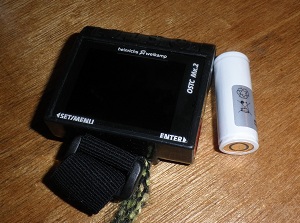 Batteries. Batteries hate being ignored. The Sentinel rebreather decided that
it wasn't going to wake up to having two high pressure sensors. They had both
dropped out. Now I'm pretty much resigned to the Sentinel giving me grief and
I'm used to having to do the work rounds but it still erks me when it does it.
In this case I'm sure the sensors were OK. The Sentinel was confused but I
didn't have time to risk deconfusing it.
Batteries. Batteries hate being ignored. The Sentinel rebreather decided that
it wasn't going to wake up to having two high pressure sensors. They had both
dropped out. Now I'm pretty much resigned to the Sentinel giving me grief and
I'm used to having to do the work rounds but it still erks me when it does it.
In this case I'm sure the sensors were OK. The Sentinel was confused but I
didn't have time to risk deconfusing it.
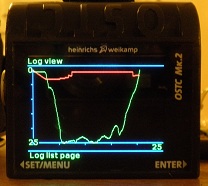 Then the DiveSoft gas analyser needed a new PP3. This one foxed me because my
first move was to plug in the external power but that didn't help and the metal
case had that slight tingle of mains voltage so I suspect the PSU has eaten
itself. However I have PP3s in the kitchen cupboard so it was just a matter of
undoing the battery case and putting in a new one. <sigh>It was
important as although I blend very carefully using very careful maths I like to
analyse the end results just in case I've done something daft. If I can't
measure it I'm not going to breathe it.
Then the DiveSoft gas analyser needed a new PP3. This one foxed me because my
first move was to plug in the external power but that didn't help and the metal
case had that slight tingle of mains voltage so I suspect the PSU has eaten
itself. However I have PP3s in the kitchen cupboard so it was just a matter of
undoing the battery case and putting in a new one. <sigh>It was
important as although I blend very carefully using very careful maths I like to
analyse the end results just in case I've done something daft. If I can't
measure it I'm not going to breathe it.
The cameras all needed charging or new AA cells in the flash but that's pretty
normal. That always happens. That didn't worry me.
But then, horror of horrors, my beloved home programmed OSTC dive computer was
flat. An evening on charge didn't phase it so I pulled the rechargeable and
didn't recognise it. I didn't even recognise the concentric flat connectors at
the working end. Worst still the web sites of my local suppliers didn't
recognise it either so I was faced with that being out as I just didn't have
the time to order one. Getting desperate I started measuring things but there
wasn't much to see. It was just not there. Totally open circuit.
So I was bemoaning my lot on the Yorkshire Divers Forum, as I do because it
stops me throwing a toddler temper tantrum and breaking something. Writing
something down makes me see the stupid side of things, usually me, but Rob
Dobson suddenly offered to send the right battery to Valkyrie for the day I
arrived. "You shall go to the Ball Cinderella".
To say I was delighted would be rather understating it. I have been
progressively reprogramming that computer for months as I develop my ideas on
sensible dive computer interfaces and to have left it at home would have been
so sad.
Friday and Saturday
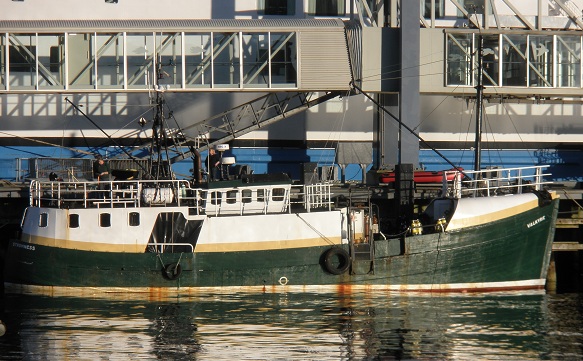 Friday was invested in mileage. I left Brighton at five to seven, topped up the
fuel and then drove all day. I was picking up Andy just north of Preston so it
was 290 miles to get there for a predicted meet up at about 12ish. It was a
drag but I arrived on time, got Andy loaded, punched our overnight lodgings in
Inverness into the GPS and was offered the next 345 miles but with the prospect
of getting through the Cairngorms in daylight.
Friday was invested in mileage. I left Brighton at five to seven, topped up the
fuel and then drove all day. I was picking up Andy just north of Preston so it
was 290 miles to get there for a predicted meet up at about 12ish. It was a
drag but I arrived on time, got Andy loaded, punched our overnight lodgings in
Inverness into the GPS and was offered the next 345 miles but with the prospect
of getting through the Cairngorms in daylight.
The weather kept looking like it was getting better and then didn't quite make
it but we did get over the high part in daylight. I've hit driving sleet on
that part of the journey before and that doesn't feel like good auspices for a
diving holiday but this was just a bit wet.
We arrived, checked in and took directions for the Castle Tavern for a meal. We
probably didn't do the directions very well because the walk back was based on
the GPS in my pocket and seemed a lot quicker. While we were eating it poured
down but by the time we were leaving it was stopping. We did breakfast at 7.30
and got underway on the last 130?? miles.
After all the motorway hacking of the day before I always enjoy the run up the
coast from Inverness and the final cut across the hills to Scrabster and this
was a good day after the night before's rain. We arrived in plenty of time for
the ferry and found most of the rest of the divers for the week already there.
From then on it was a normal ferry crossing and since you can see Valkyrie from
the deck roll round in a convoy and start to human chain the stuff onto the
deck.
Hazel, the skipper, had my battery and she did the briefing including the
mandatory safety stuff and then I took the car off to the long stay free park
(YES, Orkney has long stay free parking close to the ferry.) Saturday is the
crew day off so we wandered out and turned up the chip van (highly recomended)
and ate and slept.
Sunday
Kitting up I hit an annoyance. My latex cuffs are going sticky and one looks
like it is beginning to tear. Fortunately the neck seal looks pristine so it's
probably OK. I take the option to dive as even a flood would only be
uncomfortable and a tumble in a dryer.
The Karlsruhe is a nice shallow 'first dive'. Hazel did us a briefing
telling us where she would put us on the wreck, where to go and what to look
for. It's 28 meters to the sand with plenty of ship left even though it has
been well salvaged. I set the tone of my last down/first up easy diving trip
and even though the Sentinel try's to annoy me on the surface it does the
business underwater as I have it trimmed out to be very comfortable. I mooched
about round the bow, poked my head into the forward guns and then started aft
but came upon the shot line so decided to call it a day a bit early. Back on
the boat and Rob is helping me lash it up and plying me with tea. Annoyingly I
had missed the fact that the VeeCam on my mask has switched out of auto
exposure mode so I didn't get any real video footage as it was bleached out on
the boat and pitch black on the wreck.
The second dive was the F2/Barge combo. Now I confess I've never really
dived the barge before. It was always the quick route to the warship but Hazel
did a good intro so I spent my time there. Before it has usually been a big
slab wall that I swim along to the rope over to the F2. This, clearly, has been
a mistake. The Barge has two large open holds and a bunch or rooms. OK I didn't
venture inside as most of the ones I saw were of a size to poke your head and
the torch in and you see most of it but it was a working barge and you can
picture it. Last down first up again but a good dive.
Helen promised food at about six so I went for a walk with my suit thrown over
my shoulder down to Scapa Scuba. New cuffs and some glue on the Russian IDA
diver badge that covers the hole the mice nibbled in the arm were paid for and
he wrote the name of the boat on the ticket. Derick and I continued along the
road and I was introduced to Geo-caching. This seems to be a light hearted game
about finding things by their GPS coordinates and as it took us up to an old
gun lookout above old Stromness it was a nice walk. We, or at least Derick,
scored one good find, one too wet to sign in and one no-show.
It seems to get dark early up here but in reality that's probably because it
never gets really dark at home where the whole of Sussex is well lit all night
so the sky never goes dark. After eating too much I sat about for a bit then
decided to go to bed early and cuddle up with a warm laptop and go into short
story mode. Not writing just the ever present chore of converting the stream of
consciousness stuff that pours out of my brain into something with punctuation,
proper sentences and enough descriptive content to put the reader in the right
context.
Monday
Over night the suit fairy visited and a lovely Otter suit, looking suspiciously
like mine, but this one had nice new conical wrist seals and a properly stuck
down badge had appeared in the changing room with all the others.
The plan for the morning dive was the Kronprinz Wilhelm. 25 thousand
tons of Battleship but Battleships are top-heavy and so they capsize as they
sink so the interesting stuff is underneath. Again the briefing was first rate,
giving you the route to follow to see the big 12 inch guns but I wasn't
tempted. It's a nearly 40 meter descent then a cave dive. I'm solo by choice
and that's not my sort of solo dive these days. I chose to sit this one out and
video the others jumping off.
The afternoon dive was the Brummer which is, apparently German for the
insect we call a 'bluebottle'. The Cruisers didn't fully capsize perhaps
because they aren't so top heavy or perhaps they just sank faster in shallower
water so she lies on one side.
I like the Cruisers so I dived this one. It's 38 meters to the sand but I
stayed about amidships or a bit below. Last in/first back again. The video
camera did much better this time.
Tuesday
We had a short delay first thing but we were off to the Markgraf.
Another Battleship but even Hazel didn't have a suggestion other than swim the
gun deck and people were loading up helium mixes for the 47 meter seabed and I
don't fancy dangling on a string to end a dive so I passed this one again. I
think I'll miss the deeper ones and that will still leave me lots to do.
Wednesday
I awarded myself an archaeology day. I videoed Hazel doing a confined space
exit from the mooring and then drove over to Maeshowe to find out what the
opening time was then ran out to the Ring of Brodgar and the Stones of Stenness
for a standing stones fix. It was a bit cold and a bit damp but I reminded
myself that if it wasn't raining you wouldn't be in Scotland and bounced off
through the mud.
Now for a Neolithic Archaeology buff Orkney is just a children's toybox. Back
in the new stone age it was quite a bit warmer, something the 'it's all our
fault' climate police fail to mention, but was probably still pretty bleak in
winter. With the growth of agriculture you could support a bigger family but
that meant you had to spread over more flat, good growing land generation by
generation so you exploited more and more marginal land further and further
north.
I was back a Maeshowe for the first tour and there was just me so I had the
guide to myself. It's a Neolithic chambered tomb with Viking graffiti claiming
to have carried away 'the treasure' in about the 10th or 11th century but the
general consensus was that they didn't get much unless it had been reused by
the later population which doesn't seem likely. Google for it if you want
details.
Next port of call was Skara Brae, the 5000 year old village. Now as this is
self guided I bought the book and settled down in the cafe to read it before
walking the site. I like the interpretation of finds at Skara Brae because some
archaeologists are too quick to say 'religious significance' to anything they
don't understand but here everything is read in a simple domestic model and
even the 'different house' is read as a workshop.
I finished off with a run down the Churchill Barriers to see if I could spot
the site where Adrian and I did our try-dive all those years ago and then back
to Stromness where Valkyrie was already tied up and waiting.
Thursday
We were diving the Kolne today. Now I've always enjoyed the Kolne
but...
Hazel recomended the book "The Man who bought a Navy" on the salvage work at
Scapa so I ordered it from Amazon. (By the time I wrote this report it had come
and I had read half of it. As ever she is right. It is a good book.)
Friday
Right. Get up reasonably promptly and put on the diving base layer under the
normal clothes because it is going to be cold and do breakfast. Once Hazel is
aboard and the generator has started I head up the ladder to see them off. It
is snowing so I took a picture but, frankly, the flash picked out the snow and
it looked worse than it was. I went off and sorted the car then wandered off to
the bank to get some folding money. I was wearing my rubber over-trousers , my
big Fladden jacket and my diving gloves (5mm neo) and I had a big packet of
'garage gloves' to make sliding them on easy and I pronounced it good kit to be
wearing in snow. I wasn't ever cold.
Actually, since my ferry wasn't until 11.40 I had lots and lots of time to
kill. I went to the Masehowe visitor centre to check out their bookshop but
they didn't have anything Rousey orientated. I parked up by the Stones of
Steness to read my books but although the snow looked picturesque I couldn't be
bothered to revisit the stones. Finally, after an excursion to a couple of odd
sites, I drove up to Tingwall to be early.
I parked up, went into the office and paid for my ticket and confirmed my
return time. The lady gave me the ferry brochure and that was the best
introduction to Rousey archaeology I'd seen yet so I sat in the car and
replanned my day based on that.
The journey was uneventful to the point of boring. OK the sea was coming over
the top but a bit of salt washes the snow off the car nicely.
I'm not saying Rousey is small but it doesn't have place names on the map so
you rely on the brown visitor attraction signs to find your way about. I moved
off to the lay-by at Taversoe Tuick to see what it was all about.
Well Taversoe Tuick is a multi-level chambered cairn and is nice and close to
the road so on with the gloves, pull up the hood, grab the torch and get
started. It was built as a lower chamber accessible via a tunnel from the south
and an upper chamber with a shorter entrance to the north. In the excavation
the floor/roof between then was disturbed so we now have a ladder inside that
wasn't part of the original design. I think the multi-layer approach is rare as
there is one other like it in Scotland so it's pretty exceptional. Both floors
have three chambers around their central core. It's a bit cramped inside and
my camera doesn't really do wide-angle so the pictures don't do it justice. It
was built, as almost everything else on these islands, with drystone technology
and probably covered with earth.
This is a good introduction to Rousey's archaeology. I've been here over ten
years ago and I carefully followed the instructions (please shut the gate)
because you are not getting a guided tour here because there is nobody to do
it. They have fenced it and provided grills to try and stop anything too
destructive living there but it is left open for you to come and see things. I
took my big Fami torch but the concrete roof that protects things has a
skylight so, except in the lower access tunnel, there is plenty of light
inside to see things which the original design definitely did not
have.
The next port of call was Blackhammer Cairn. Again good signs and a lay-by but
this one is further from the road and the field round the gate is very muddy.
Still I can pick my way round the squelchest bits and clamber up the slope to
the sheep-fenced cairn.
Now this one was definitely walled up when the original users finished with it
so, rather bust up the walls when the archaeological people roofed it over,
they put a sliding hatch in the roof for you to go in through. It's a more
standard chambered cairn built as a tunnel with large plates of rock dividing
it into rooms. It's a bit broken up so the new roof is set at a height where
the old roof probably was. Again, as you can see I didn't need the
torch.
Like Taversoe Tuick there were burials here when it was excavated but only two
although the cairn was, apparently, in use for centuries about 3000BC. It seems
reasonable to surmise that this was only a temporary resting place rather than
a Pharonic 'eternal house'. However if you are a Neolithic farmer with a couple
of bowls and a flint knife laid to rest with you you are much less likely to be
disturbed for your possessions.
On to the Knowe of Yarso. Well the mud at Blackhammer was just a warming up
exercise for this one. According to the map it's only 80 meters above the road
and only half a mile to walk but it feels like a lot more. The route starts as
a road but you divert onto a path with a bridge but very quickly it is a steep
muddy track that seemed to be auditioning for a part as a ditch when I was
there. Add the horizontal hail and only the labours of Messrs Hydrotech and
Fladden made it pleasant.
Another five thousand year old Neolithic chambered cairn. That's three
in a couple of miles !! It's not like these things are common and, remember,
they predate Stonehenge by a couple of centuries. Now I must admit I wonder
about these things. I see great tales of how much labour goes into something
but I would guess that a man and a wheelbarrow, supported by others so it was
his only job, could do it in a matter of years. After all rebuilding drystone
walling as a field divider is normally about £25 a yard plus any extra
materials so it can't take a skilled man long to build a cairn. Alternatively
maybe everybody in the community pitched in. Got to keep the community tomb up
to scratch - after all you'll be dead for a long time. Maybe a good tomb
encouraged the dead to hang around and be supportive. Perhaps it was just
respect, we all liked Granny and now she's dead we're not just leaving her body
out for the gulls and rats to eat. She goes in the family tomb until it's just
bones left. Who knows?
OK on to the main attraction Midhowe. After all, let's admit, this is why I
came to Rousey. There is an iron age broche and the chambered cairn to end all
chambered cairns. This time the road is 90 meters above the site and it's all
nice and open even if it's a bit slippery on the steep bit at the top. I admit
I sat in the lay-by and ate my lunch but I didn't drink the drink. Getting out
of all this kit could be a problem.
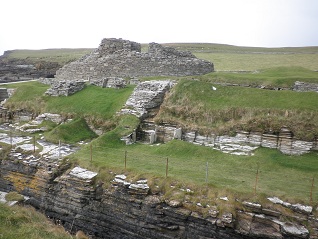 Right. Start with the Broch. We're in a
totally different era now. This is iron age or maybe bronze age so, if you can
afford them as on Orkney iron tools will be imports, you can have serious
hardware. The Romans are in Britian and the Norsemen are raiding. I tend to
think of a Broch as a defendable farm house as the main business of the people
is to generate a food supply and in these more dangerous days they then have to
plan to keep it.
Right. Start with the Broch. We're in a
totally different era now. This is iron age or maybe bronze age so, if you can
afford them as on Orkney iron tools will be imports, you can have serious
hardware. The Romans are in Britian and the Norsemen are raiding. I tend to
think of a Broch as a defendable farm house as the main business of the people
is to generate a food supply and in these more dangerous days they then have to
plan to keep it.
Midhowe Broch is built on a promenentary with a deep cut next to it. This makes
it very difficult to attack as on most sides any attackers have nowhere to hide
behind things. It is a round house with a double skinned wall. I suspect that
it spent most of its existance in farm house mode as anybody sailing past would
probably note it down as 'only raid when desperate' and pillage the easy ones
first.
The other advantage the iron age farmers had is that they could get access to
imported timber. This meant they could roof larger spans and possibly have
floors within the building. Actually the buildings are quite sophisticated. The
double skinned walls are self supporting and stable and allow for a lot of
height. Probably the animals overwintered in the house as did the family while
in the warmer months they spread to the outer buildings.
I'm a bit unsure about my photographs. The site has obviously been tidied up
and repaired. After that some visitor friendly walls and steps have been added.
I'm not quite sure what is original and what is 'that where we think it came
from'.
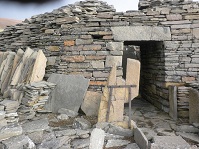
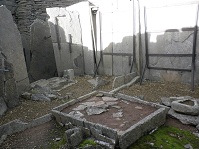
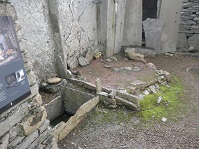
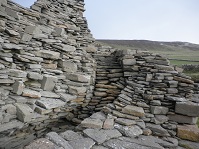
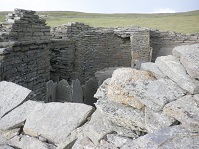
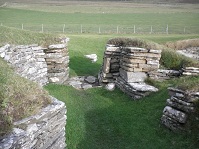
Saturday
Going home day so we're all scurrying for the ferry. Everybody looks happy and
pleased and, when you consider that they haven't seen any Chambered Cairns that
must be a testament to how good the diving was.
Sunday
Pictures by Nigel Hewitt.
I haven't bothered with putting in the full sized images but if anybody would
like them drop me a line.

 by Nigel Hewitt
by Nigel Hewitt
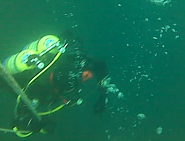
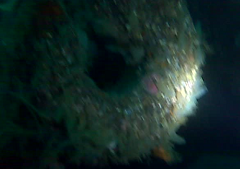
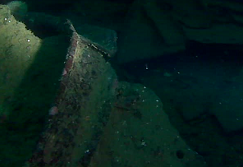
 Batteries. Batteries hate being ignored. The Sentinel rebreather decided that
it wasn't going to wake up to having two high pressure sensors. They had both
dropped out. Now I'm pretty much resigned to the Sentinel giving me grief and
I'm used to having to do the work rounds but it still erks me when it does it.
In this case I'm sure the sensors were OK. The Sentinel was confused but I
didn't have time to risk deconfusing it.
Batteries. Batteries hate being ignored. The Sentinel rebreather decided that
it wasn't going to wake up to having two high pressure sensors. They had both
dropped out. Now I'm pretty much resigned to the Sentinel giving me grief and
I'm used to having to do the work rounds but it still erks me when it does it.
In this case I'm sure the sensors were OK. The Sentinel was confused but I
didn't have time to risk deconfusing it. Then the DiveSoft gas analyser needed a new PP3. This one foxed me because my
first move was to plug in the external power but that didn't help and the metal
case had that slight tingle of mains voltage so I suspect the PSU has eaten
itself. However I have PP3s in the kitchen cupboard so it was just a matter of
undoing the battery case and putting in a new one. <sigh>It was
important as although I blend very carefully using very careful maths I like to
analyse the end results just in case I've done something daft. If I can't
measure it I'm not going to breathe it.
Then the DiveSoft gas analyser needed a new PP3. This one foxed me because my
first move was to plug in the external power but that didn't help and the metal
case had that slight tingle of mains voltage so I suspect the PSU has eaten
itself. However I have PP3s in the kitchen cupboard so it was just a matter of
undoing the battery case and putting in a new one. <sigh>It was
important as although I blend very carefully using very careful maths I like to
analyse the end results just in case I've done something daft. If I can't
measure it I'm not going to breathe it. Friday was invested in mileage. I left Brighton at five to seven, topped up the
fuel and then drove all day. I was picking up Andy just north of Preston so it
was 290 miles to get there for a predicted meet up at about 12ish. It was a
drag but I arrived on time, got Andy loaded, punched our overnight lodgings in
Inverness into the GPS and was offered the next 345 miles but with the prospect
of getting through the Cairngorms in daylight.
Friday was invested in mileage. I left Brighton at five to seven, topped up the
fuel and then drove all day. I was picking up Andy just north of Preston so it
was 290 miles to get there for a predicted meet up at about 12ish. It was a
drag but I arrived on time, got Andy loaded, punched our overnight lodgings in
Inverness into the GPS and was offered the next 345 miles but with the prospect
of getting through the Cairngorms in daylight.


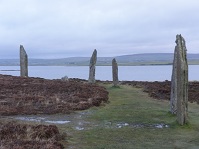
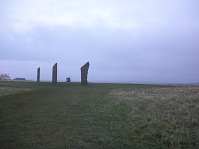
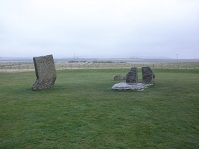
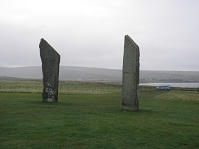
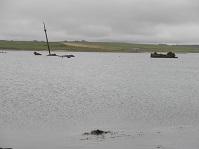
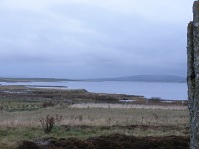
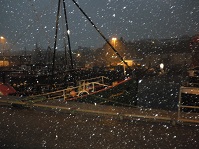
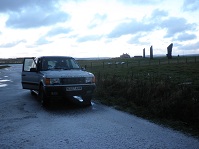
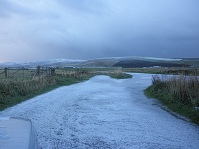
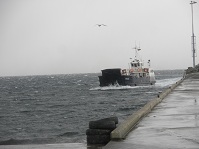
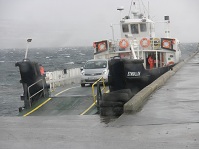
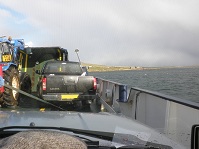
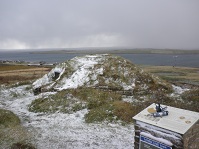
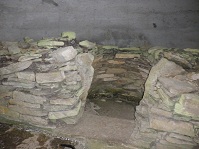
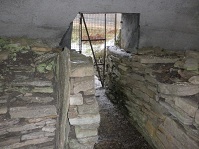
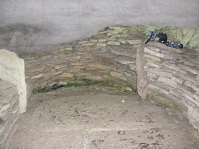
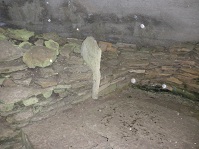
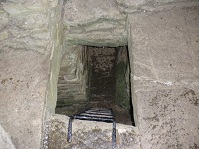
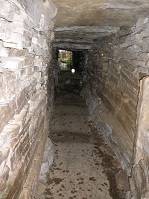
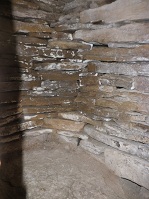
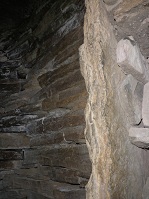
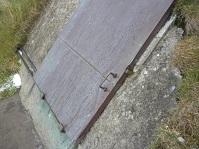
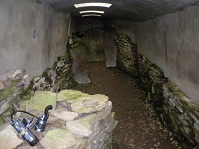
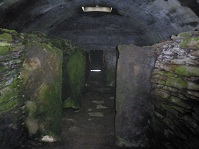
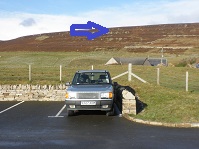
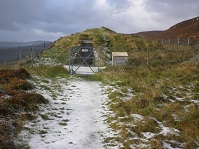
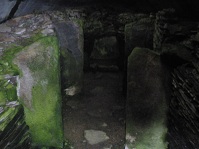
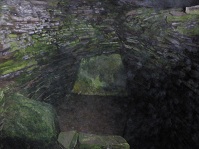
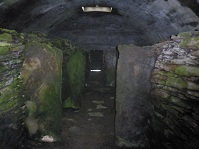
 Right. Start with the Broch. We're in a
totally different era now. This is iron age or maybe bronze age so, if you can
afford them as on Orkney iron tools will be imports, you can have serious
hardware. The Romans are in Britian and the Norsemen are raiding. I tend to
think of a Broch as a defendable farm house as the main business of the people
is to generate a food supply and in these more dangerous days they then have to
plan to keep it.
Right. Start with the Broch. We're in a
totally different era now. This is iron age or maybe bronze age so, if you can
afford them as on Orkney iron tools will be imports, you can have serious
hardware. The Romans are in Britian and the Norsemen are raiding. I tend to
think of a Broch as a defendable farm house as the main business of the people
is to generate a food supply and in these more dangerous days they then have to
plan to keep it.





 by Nigel Hewitt
by Nigel Hewitt